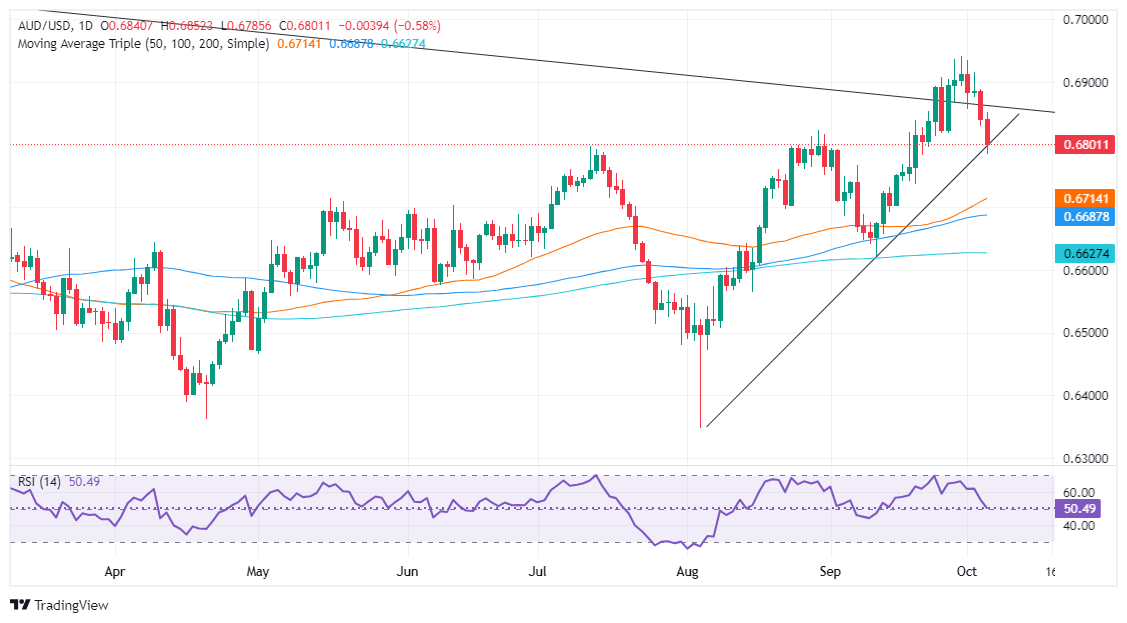- AUD/USD falls after strong US non-farm payrolls data, reducing the likelihood of aggressive rate cuts by the Fed.
- Fed Chair Powell signals a slower pace of easing, with markets now pricing in a 25bp cut by November.
- Australian data shows mixed results with strong retail sales and trade surpluses, but a continued contraction in manufacturing and a slowdown in business activity.
The Australian dollar fell during the North American session after the United States (US) September jobs report, suggesting that the Federal Reserve (Fed) will not cut rates by 50 basis points (bps) at the November meeting. AUD/USD is trading at 0.6796, down more than 0.60%.
AUD/USD extended its losses following the September US non-farm payrolls report, which reduced the unemployment rate. Average hourly earnings were mixed, although the data generally relieved the Fed from cutting rates aggressively.
In September, the Fed cut rates by 50 bps. Swaps markets showed investors had been expecting another cut of the same size at the November or December meeting. However, Fed Chair Jerome Powell pushed back against this stance on Monday, saying officials envision full 50bp easing by the end of 2024 and that the US central bank is in no rush to cut. the rates.
According to data from the CME FedWatch tool, markets had priced in a 25 bp cut in the Fed’s interest rate probabilities at the November meeting.
Apart from this, Australian data showed a strong retail sales report, and the trade balance in August posted a surplus. Although those conditions could prevent the Reserve Bank of Australia (RBA) from cutting rates, business activity in the manufacturing sector, via the Judo Bank Manufacturing PMI, has contracted for eight consecutive months.
On the other hand, Judo Bank Services PMI slowed sharply, while construction permits plummeted, suggesting an ongoing economic slowdown.
Next week, Australia’s economic agenda will include business and consumer confidence data, RBA speakers and minutes from the latest RBA meeting. On the US front, the calendar will include the release of inflation data, jobless claims and consumer sentiment from the University of Michigan.
Daily summary of market drivers: Australian dollar depreciates on US data and geopolitical risks
- The Australian Dollar is likely to remain pressured due to several factors. Geopolitical risks, such as the weekend’s developments in the Middle East, could impact AUD risk appetite.
- Australia’s economic agenda will include NAB Business Confidence and Westpac Consumer Confidence for September and October respectively. After that, traders await speeches from Hauser, Kent and Hunter of the RBA.
- US nonfarm payrolls increased by 254,000 in September, significantly exceeding the estimate of 140,000 and August’s upwardly revised figure of 159,000. The unemployment rate fell from 4.2% to 4.1%, lower than expected.
- Average hourly earnings in September rose 0.4% month-on-month, down from 0.5% the previous month but beating forecasts of 0.3%.
- On a year-on-year basis, hourly earnings rose 4% in the 12 months to September, beating estimates and improving on August figures of 3.8% and 3.9%.
- Market participants have ruled out a 50bp cut by the Fed. The odds of a 25bp cut stand at 95%, with only a 5% chance of rates remaining unchanged, according to analysts. data from CME FedWatch tool.
Technical Analysis: Australian Dollar extends losses below 0.6800
Despite retracing below the 0.6800 figure, AUD/USD remains bullishly biased. Momentum is mixed with the Relative Strength Index (RSI) remaining bullish but hinting at a drop into bearish territory.
AUD/USD could accelerate its losses if it breaks the September 6 peak at 0.6767. Once subsided, the next demand area will be the 50-day SMA at 0.6712.
On the other hand, if buyers lift AUD/USD above 0.6800, the first supply zone will be the October 1, 2024 low at 0.6856. A break of the latter will expose 0.6900 before retesting the current year high of 0.6934.
The Australian Dollar FAQs
One of the most important factors for the Australian Dollar (AUD) is the level of interest rates set by the Reserve Bank of Australia (RBA). As Australia is a resource-rich country, another key factor is the price of its largest export, iron ore. The health of the Chinese economy, its largest trading partner, is a factor, as is inflation in Australia, its growth rate and the Balance of Trade. Market sentiment, that is, whether investors bet on riskier assets (risk-on) or seek safe havens (risk-off), is also a factor, with the risk-on being positive for the AUD.
The Reserve Bank of Australia (RBA) influences the Australian Dollar (AUD) by setting the level of interest rates that Australian banks can lend to each other. This influences the level of interest rates in the economy as a whole. The RBA’s main objective is to maintain a stable inflation rate of 2%-3% by adjusting interest rates up or down. Relatively high interest rates compared to other major central banks support the AUD, and the opposite for relatively low ones. The RBA can also use quantitative easing and tightening to influence credit conditions, with the former being negative for the AUD and the latter being positive for the AUD.
China is Australia’s largest trading partner, so the health of the Chinese economy greatly influences the value of the Australian Dollar (AUD). When the Chinese economy is doing well, it buys more raw materials, goods and services from Australia, which increases demand for the AUD and drives up its value. The opposite occurs when the Chinese economy does not grow as fast as expected. Therefore, positive or negative surprises in Chinese growth data usually have a direct impact on the Australian Dollar.
Iron ore is Australia’s largest export, with $118 billion a year according to 2021 data, with China being its main destination. The iron ore price, therefore, may be a driver of the Australian dollar. Typically, if the price of iron ore rises, the AUD also rises as aggregate demand for the currency increases. The opposite occurs when the price of iron ore falls. Higher iron ore prices also tend to result in a higher likelihood of a positive trade balance for Australia, which is also positive for the AUD.
The trade balance, which is the difference between what a country earns from its exports and what it pays for its imports, is another factor that can influence the value of the Australian dollar. If Australia produces highly sought-after exports, its currency will gain value solely from the excess demand created by foreign buyers wanting to purchase its exports versus what it spends on purchasing imports. Therefore, a positive net trade balance strengthens the AUD, with the opposite effect if the trade balance is negative.
Source: Fx Street
I am Joshua Winder, a senior-level journalist and editor at World Stock Market. I specialize in covering news related to the stock market and economic trends. With more than 8 years of experience in this field, I have become an expert in financial reporting.








